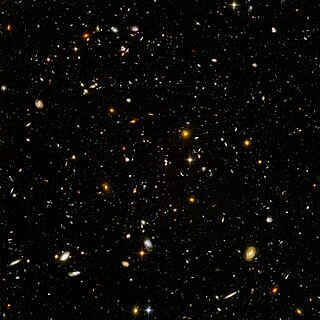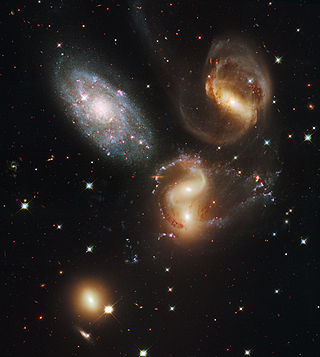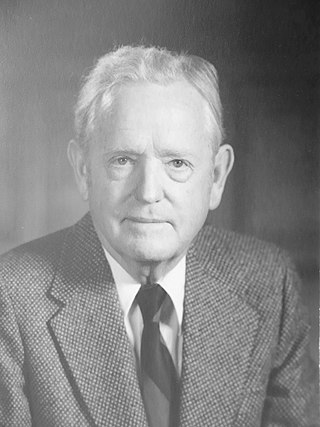Related Research Articles

In metaphysics, ontology is the philosophical study of being. It investigates what types of entities exist, how they are grouped into categories, and how they are related to one another on the most fundamental level. Ontologists often try to determine what the categories or highest kinds are and how they form a system of categories that encompasses the classification of all entities. Commonly proposed categories include substances, properties, relations, states of affairs, and events. These categories are characterized by fundamental ontological concepts, including particularity and universality, abstractness and concreteness, or possibility and necessity. Of special interest is the concept of ontological dependence, which determines whether the entities of a category exist on the most fundamental level. Disagreements within ontology are often about whether entities belonging to a certain category exist and, if so, how they are related to other entities.
Process philosophy, also ontology of becoming, or processism, is an approach in philosophy that identifies processes, changes, or shifting relationships as the only real experience of everyday living. In opposition to the classical view of change as illusory or accidental, process philosophy posits transient occasions of change or becoming as the only fundamental things of the ordinary everyday real world.

The world is the totality of entities, the whole of reality, or everything that is. The nature of the world has been conceptualized differently in different fields. Some conceptions see the world as unique while others talk of a "plurality of worlds". Some treat the world as one simple object while others analyze the world as a complex made up of parts. In scientific cosmology, the world or universe is commonly defined as "[t]he totality of all space and time; all that is, has been, and will be". Theories of modality talk of possible worlds as complete and consistent ways how things could have been. Phenomenology, starting from the horizon of co-given objects present in the periphery of every experience, defines the world as the biggest horizon or the "horizon of all horizons". In philosophy of mind, the world is contrasted with the mind as that which is represented by the mind. Theology conceptualizes the world in relation to God, for example, as God's creation, as identical to God or as the two being interdependent. In religions, there is a tendency to downgrade the material or sensory world in favor of a spiritual world to be sought through religious practice. A comprehensive representation of the world and our place in it, as is found in religions, is known as a worldview. Cosmogony is the field that studies the origin or creation of the world while eschatology refers to the science or doctrine of the last things or of the end of the world.

Reality is the sum or aggregate of all that is real or existent within the universe, as opposed to that which is only imaginary, nonexistent or nonactual. The term is also used to refer to the ontological status of things, indicating their existence. In physical terms, reality is the totality of a system, known and unknown.
Modal logic is a kind of logic used to represent statements about necessity and possibility. It plays a major role in philosophy and related fields as a tool for understanding concepts such as knowledge, obligation, and causation. For instance, in epistemic modal logic, the formula can be used to represent the statement that is known. In deontic modal logic, that same formula can represent that is a moral obligation. Modal logic considers the inferences that modal statements give rise to. For instance, most epistemic logics treat the formula as a tautology, representing the principle that only true statements can count as knowledge.
Truthmaker theory is "the branch of metaphysics that explores the relationships between what is true and what exists". The basic intuition behind truthmaker theory is that truth depends on being. For example, a perceptual experience of a green tree may be said to be true because there actually is a green tree. But if there were no tree there, it would be false. So the experience by itself does not ensure its truth or falsehood, it depends on something else. Expressed more generally, truthmaker theory is the thesis that "the truth of truthbearers depends on the existence of truthmakers". A perceptual experience is the truthbearer in the example above. Various representational entities, like beliefs, thoughts or assertions can act as truthbearers. Truthmaker theorists are divided about what type of entity plays the role of truthmaker; popular candidates include states of affairs and tropes.
Philosophy of space and time is the branch of philosophy concerned with the issues surrounding the ontology and epistemology of space and time. While such ideas have been central to philosophy from its inception, the philosophy of space and time was both an inspiration for and a central aspect of early analytic philosophy. The subject focuses on a number of basic issues, including whether time and space exist independently of the mind, whether they exist independently of one another, what accounts for time's apparently unidirectional flow, whether times other than the present moment exist, and questions about the nature of identity.
In philosophy, metaphysical necessity, sometimes called broad logical necessity, is one of many different kinds of necessity, which sits between logical necessity and nomological necessity, in the sense that logical necessity entails metaphysical necessity, but not vice versa, and metaphysical necessity entails physical necessity, but not vice versa. A proposition is said to be necessary if it could not have failed to be the case. Nomological necessity is necessity according to the laws of physics and logical necessity is necessity according to the laws of logic, while metaphysical necessities are necessary in the sense that the world could not possibly have been otherwise. What facts are metaphysically necessary, and on what basis we might view certain facts as metaphysically but not logically necessary are subjects of substantial discussion in contemporary philosophy.
A possible world is a complete and consistent way the world is or could have been. Possible worlds are widely used as a formal device in logic, philosophy, and linguistics in order to provide a semantics for intensional and modal logic. Their metaphysical status has been a subject of controversy in philosophy, with modal realists such as David Lewis arguing that they are literally existing alternate realities, and others such as Robert Stalnaker arguing that they are not.
In analytic philosophy, actualism is the view that everything there is is actual. Another phrasing of the thesis is that the domain of unrestricted quantification ranges over all and only actual existents.
Subjunctive possibility is a form of modality studied in modal logic. Subjunctive possibilities are the sorts of possibilities considered when conceiving counterfactual situations; subjunctive modalities are modalities that bear on whether a statement might have been or could be true—such as might, could, must, possibly, necessarily, contingently, essentially, accidentally, and so on. Subjunctive possibilities include logical possibility, metaphysical possibility, nomological possibility, and temporal possibility.
Modal realism is the view propounded by philosopher David Lewis that all possible worlds are real in the same way as is the actual world: they are "of a kind with this world of ours." It is based on four tenets: possible worlds exist, possible worlds are not different in kind from the actual world, possible worlds are irreducible entities, and the term actual in actual world is indexical, i.e. any subject can declare their world to be the actual one, much as they label the place they are "here" and the time they are "now".

Process and Reality is a book by Alfred North Whitehead, in which the author propounds a philosophy of organism, also called process philosophy. The book, published in 1929, is a revision of the Gifford Lectures he gave in 1927–28.
We diverge from Descartes by holding that what he has described as primary attributes of physical bodies, are really the forms of internal relationships between actual occasions. Such a change of thought is the shift from materialism to Organic Realism, as a basic idea of physical science.
Perdurantism or perdurance theory is a philosophical theory of persistence and identity. The debate over persistence currently involves three competing theories—one three-dimensionalist theory called "endurantism" and two four-dimensionalist theories called "perdurantism" and "exdurantism". For a perdurantist, all objects are considered to be four-dimensional worms and they make up the different regions of spacetime. It is a fusion of all the perdurant's instantaneous time slices compiled and blended into a complete mereological whole. Perdurantism posits that temporal parts alone are what ultimately change. Katherine Hawley in How Things Persist states that change is "the possession of different properties by different temporal parts of an object".
Parallel universe may refer to:
In philosophy, four-dimensionalism is the ontological position that an object's persistence through time is like its extension through space. Thus, an object that exists in time has temporal parts in the various subregions of the total region of time it occupies, just like an object that exists in a region of space has at least one part in every subregion of that space.
In contemporary metaphysics, temporal parts are the parts of an object that exist in time. A temporal part would be something like "the first year of a person's life", or "all of a table from between 10:00 a.m. on June 21, 1994 to 11:00 p.m. on July 23, 1996". The term is used in the debate over the persistence of material objects. Objects typically have parts that exist in space—a human body, for example, has spatial parts like hands, feet, and legs. Some metaphysicists believe objects have temporal parts as well.
In philosophy, specifically in the area of metaphysics, counterpart theory is an alternative to standard (Kripkean) possible-worlds semantics for interpreting quantified modal logic. Counterpart theory still presupposes possible worlds, but differs in certain important respects from the Kripkean view. The form of the theory most commonly cited was developed by David Lewis, first in a paper and later in his book On the Plurality of Worlds.
In mereology, an area of philosophical logic, the term gunk applies to any whole whose parts all have further proper parts. That is, a gunky object is not made of indivisible atoms or simples. Because parthood is transitive, any part of gunk is itself gunk.

Donald Cary Williams, usually cited as D. C. Williams, was an American philosopher and a professor at both the University of California Los Angeles and at Harvard University.
References
- ↑ Parent, Ted. "Modal Metaphysics". Internet Encyclopedia of Philosophy. Retrieved 6 December 2020.
- ↑ Honderich, Ted. "Modal realism". The Oxford Companion to Philosophy. Oxford University Press.
- 1 2 Lewis, David (1986). On the Plurality of Worlds. Wiley-Blackwell.
- 1 2 3 4 5 6 7 Yagisawa, Takashi (2009). Worlds and Individuals, Possible and Otherwise. Oxford University Press.
- ↑ Menzel, Christopher (2017). Possible Worlds. Metaphysics Research Lab, Stanford University.
{{cite encyclopedia}}:|website=ignored (help) - ↑ Ballarin, Roberta (2011). "The Perils of Primitivism: Takashi Yagisawa's Worlds and Individuals, Possible and Otherwise". Analytic Philosophy. 52 (4): 273–282. doi:10.1111/j.2153-960X.2011.00535.x.
- 1 2 3 4 Yagisawa, Takashi (2011). "Précis of Worlds and Individuals, Possible and Otherwise". Analytic Philosophy. 52 (4): 270–272. doi:10.1111/j.2153-960X.2011.00534.x.
- ↑ Thomas, Andrew D. (2020). "Extended Modal Realism — a New Solution to the Problem of Intentional Inexistence". Philosophia. 48 (3): 1197–1208. doi: 10.1007/s11406-019-00126-z .
- ↑ Sider, Theodore (2001). Four Dimensionalism: An Ontology of Persistence and Time. Oxford University Press.
- 1 2 Vacek, Martin (2017). "Extended Modal Dimensionalism". Acta Analytica. 32 (1): 13–28. doi:10.1007/s12136-016-0297-9.
- ↑ Berto, Francesco; Jago, Mark (2018). Impossible Worlds. Metaphysics Research Lab, Stanford University.
{{cite encyclopedia}}:|website=ignored (help) - 1 2 Yagisawa, Takashi (2015). "Impossibilia and Modally Tensed Predication". Acta Analytica. 30 (4): 317–323. doi:10.1007/s12136-015-0254-z.
- 1 2 Divers, J. (2011). "Worlds and Individuals, Possible and Otherwise, by Takashi Yagisawa". Mind. 120 (478): 570–574. doi:10.1093/mind/fzr027.
- ↑ Schaffer, Jonathan (2015). "What Not to Multiply Without Necessity" (PDF). Australasian Journal of Philosophy. 93 (4): 644–664. doi:10.1080/00048402.2014.992447. S2CID 16923735.
- ↑ Parent, Ted. "Modal Metaphysics". Internet Encyclopedia of Philosophy.
- ↑ Kim, Seahwa (2011). "Understanding Yagisawa's Worlds". Analytic Philosophy. 52 (4): 293–301. doi:10.1111/j.2153-960X.2011.00537.x.
- ↑ Jago, Mark (2013). "Against Yagisawa's Modal Realism". Analysis. 73 (1): 10–17. doi:10.1093/analys/ans132.